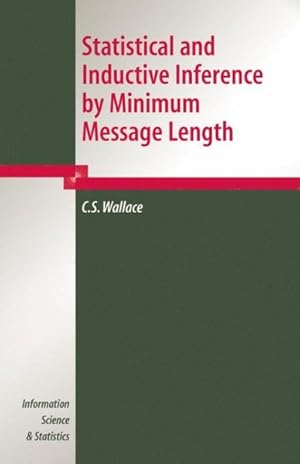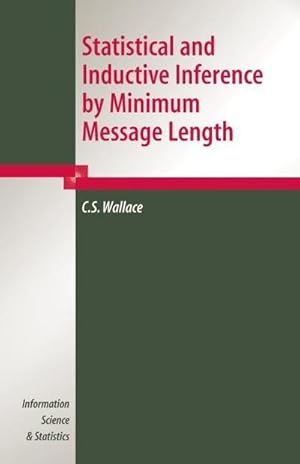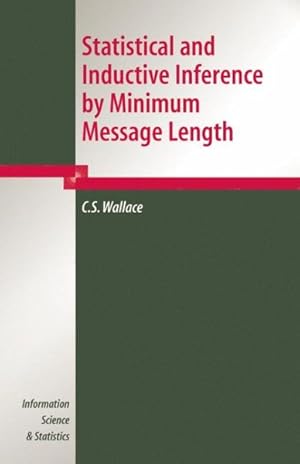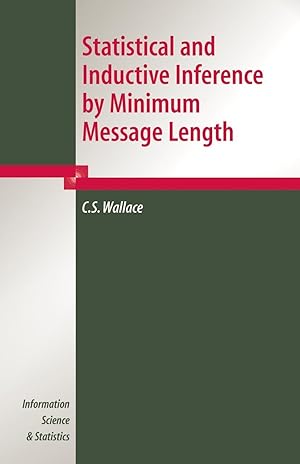Statistical Inductive Inference Minimum by Wallace C S (32 results)
Search filters
Product Type
- All Product Types
- Books (32)
- Magazines & Periodicals (No further results match this refinement)
- Comics (No further results match this refinement)
- Sheet Music (No further results match this refinement)
- Art, Prints & Posters (No further results match this refinement)
- Photographs (No further results match this refinement)
- Maps (No further results match this refinement)
- Manuscripts & Paper Collectibles (No further results match this refinement)
Condition Learn more
- New (27)
- As New, Fine or Near Fine (3)
- Very Good or Good (1)
- Fair or Poor (No further results match this refinement)
- As Described (1)
Binding
Collectible Attributes
- First Edition (No further results match this refinement)
- Signed (No further results match this refinement)
- Dust Jacket (No further results match this refinement)
- Seller-Supplied Images (12)
- Not Print on Demand (29)
Language (2)
Free Shipping
Seller Location
Seller Rating
-
Statistical And Inductive Inference By Minimum Message Length (Hb)
Book 3 of 20: Information Science and StatisticsSeller: Romtrade Corp., STERLING HEIGHTS, MI, U.S.A.
Condition: New. This is a Brand-new US Edition. This Item may be shipped from US or any other country as we have multiple locations worldwide.
-
Condition: New. Brand New Original US Edition. Customer service! Satisfaction Guaranteed.
-
Condition: Brand New. New. US edition. Excellent Customer Service.
-
Statistical And Inductive Inference By Minimum Message Length (Hb)
Book 3 of 20: Information Science and StatisticsSeller: UK BOOKS STORE, London, LONDO, United Kingdom
Condition: New. Brand New! Fast Delivery This is an International Edition and ship within 24-48 hours. Deliver by FedEx and Dhl, & Aramex, UPS, & USPS and we do accept APO and PO BOX Addresses. Order can be delivered worldwide within 7-10 days and we do have flat rate for up to 2LB. Extra shipping charges will be requested if the Book weight is more than 5 LB. This Item May be shipped from India, United states & United Kingdom. Depending on your location and availability.
-
Brand new book. Fast ship. Please provide full street address as we are not able to ship to P O box address.
-
Brand new book. Fast ship. Please provide full street address as we are not able to ship to P O box address.
-
Statistical and Inductive Inference by Minimum Message Length.
Published by Springer, 2005., 2005
Seller: The Book Firm, Subiaco, WA, Australia
Hardcover. Slight sunning to top edge of front cover and spine, otherwise very good condition. No dustjacket. Part of the Springer Information Science & Statistics series. 429pp. ISBN-10 038723795X ISBN-13: ISBN-13: 9780387237954.
-
Condition: Brand New. New. US edition. Expediting shipping for all USA and Europe orders excluding PO Box. Excellent Customer Service.
-
STATISTICAL AND INDUCTIVE INFERENCE BY MINIMUM MESSAGE LENGTH
Book 3 of 20: Information Science and StatisticsSeller: Romtrade Corp., STERLING HEIGHTS, MI, U.S.A.
Condition: New. This is a Brand-new US Edition. This Item may be shipped from US or any other country as we have multiple locations worldwide.
-
Condition: New. Brand New Original US Edition. Customer service! Satisfaction Guaranteed.
-
Brand new book. Fast ship. Please provide full street address as we are not able to ship to P O box address.
-
Statistical And Inductive Inference By Minimum Message Length
Book 3 of 20: Information Science and StatisticsSeller: Romtrade Corp., STERLING HEIGHTS, MI, U.S.A.
Condition: New. This is a Brand-new US Edition. This Item may be shipped from US or any other country as we have multiple locations worldwide.
-
Brand new book. Fast ship. Please provide full street address as we are not able to ship to P O box address.
-
Condition: New.
-
Statistical and Inductive Inference by Minimum Message Length (Information Science and Statistics)
Book 3 of 20: Information Science and StatisticsSeller: Ria Christie Collections, Uxbridge, United Kingdom
US$ 140.45
US$ 15.69 shipping from United Kingdom to U.S.A.Quantity: Over 20 available
Add to basketCondition: New. In.
-
Statistical And Inductive Inference By Minimum Message Length
Book 3 of 20: Information Science and StatisticsSeller: GreatBookPrices, Columbia, MD, U.S.A.
Condition: New.
-
Condition: New.
-
Statistical and Inductive Inference by Minimum Message Length (Information Science and Statistics)
Book 3 of 20: Information Science and StatisticsSeller: Ria Christie Collections, Uxbridge, United Kingdom
US$ 180.92
US$ 15.69 shipping from United Kingdom to U.S.A.Quantity: Over 20 available
Add to basketCondition: New. In.
-
Statistical And Inductive Inference By Minimum Message Length
Book 3 of 20: Information Science and StatisticsSeller: GreatBookPricesUK, Woodford Green, United Kingdom
US$ 180.91
US$ 19.64 shipping from United Kingdom to U.S.A.Quantity: Over 20 available
Add to basketCondition: New.
-
Statistical and Inductive Inference by Minimum Message Length
Book 3 of 20: Information Science and StatisticsSeller: preigu, Osnabrück, Germany
Taschenbuch. Condition: Neu. Statistical and Inductive Inference by Minimum Message Length | C. S. Wallace | Taschenbuch | xvi | Englisch | 2010 | Humana | EAN 9781441920157 | Verantwortliche Person für die EU: Springer Verlag GmbH, Tiergartenstr. 17, 69121 Heidelberg, juergen[dot]hartmann[at]springer[dot]com | Anbieter: preigu.
-
Statistical And Inductive Inference By Minimum Message Length
Book 3 of 20: Information Science and StatisticsSeller: GreatBookPrices, Columbia, MD, U.S.A.
Condition: As New. Unread book in perfect condition.
-
Taschenbuch. Condition: Neu. Druck auf Anfrage Neuware - Printed after ordering - Mythanksareduetothemanypeoplewhohaveassistedintheworkreported here and in the preparation of this book. The work is incomplete and this account of it rougher than it might be. Such virtues as it has owe much to others; the faults are all mine. MyworkleadingtothisbookbeganwhenDavidBoultonandIattempted to develop a method for intrinsic classi cation. Given data on a sample from some population, we aimed to discover whether the population should be considered to be a mixture of di erent types, classes or species of thing, and, if so, how many classes were present, what each class looked like, and which things in the sample belonged to which class. I saw the problem as one of Bayesian inference, but with prior probability densities replaced by discrete probabilities re ecting the precision to which the data would allow parameters to be estimated. Boulton, however, proposed that a classi cation of the sample was a way of brie y encoding the data: once each class was described and each thing assigned to a class, the data for a thing would be partially implied by the characteristics of its class, and hence require little further description. After some weeks' arguing our cases, we decided on the maths for each approach, and soon discovered they gave essentially the same results. Without Boulton's insight, we may never have made the connection between inference and brief encoding, which is the heart of this work.
-
Statistical And Inductive Inference By Minimum Message Length
Book 3 of 20: Information Science and StatisticsSeller: GreatBookPricesUK, Woodford Green, United Kingdom
US$ 205.31
US$ 19.64 shipping from United Kingdom to U.S.A.Quantity: Over 20 available
Add to basketCondition: As New. Unread book in perfect condition.
-
Statistical and Inductive Inference by Minimum Message Length (Information Science and Statistics)
Book 3 of 20: Information Science and StatisticsSeller: Mispah books, Redhill, SURRE, United Kingdom
Paperback. Condition: Like New. Like New. book.
-
Statistical and Inductive Inference by Minimum Message Length
Book 3 of 20: Information Science and StatisticsPublished by Springer-Verlag New York Inc., US, 2005
ISBN 10: 038723795X ISBN 13: 9780387237954
Language: English
Seller: Rarewaves.com USA, London, LONDO, United Kingdom
Hardback. Condition: New. 2005 ed. Mythanksareduetothemanypeoplewhohaveassistedintheworkreporte d here and in the preparation of this book. The work is incomplete and this account of it rougher than it might be. Such virtues as it has owe much to others; the faults are all mine. MyworkleadingtothisbookbeganwhenDavidBoultonandIattempted to develop a method for intrinsic classi?cation. Given data on a sample from some population, we aimed to discover whether the population should be considered to be a mixture of di?erent types, classes or species of thing, and, if so, how many classes were present, what each class looked like, and which things in the sample belonged to which class. I saw the problem as one of Bayesian inference, but with prior probability densities replaced by discrete probabilities re?ecting the precision to which the data would allow parameters to be estimated. Boulton, however, proposed that a classi?cation of the sample was a way of brie?y encoding the data: once each class was described and each thing assigned to a class, the data for a thing would be partially implied by the characteristics of its class, and hence require little further description. After some weeks' arguing our cases, we decided on the maths for each approach, and soon discovered they gave essentially the same results. Without Boulton's insight, we may never have made the connection between inference and brief encoding, which is the heart of this work.
-
Gebunden. Condition: New. Since 1965, Professor Wallace and others have been developing an approach tostatistical estimation, hypothesis testing, model selection and their applications in the Artificial Intelligence field of Machine LearningMythanksareduetothemanypeoplewh.
-
Statistical and Inductive Inference by Minimum Message Length
Book 3 of 20: Information Science and StatisticsPublished by Springer-Verlag New York Inc., US, 2005
ISBN 10: 038723795X ISBN 13: 9780387237954
Language: English
Seller: Rarewaves.com UK, London, United Kingdom
US$ 248.54
US$ 85.12 shipping from United Kingdom to U.S.A.Quantity: Over 20 available
Add to basketHardback. Condition: New. 2005 ed. Mythanksareduetothemanypeoplewhohaveassistedintheworkreporte d here and in the preparation of this book. The work is incomplete and this account of it rougher than it might be. Such virtues as it has owe much to others; the faults are all mine. MyworkleadingtothisbookbeganwhenDavidBoultonandIattempted to develop a method for intrinsic classi?cation. Given data on a sample from some population, we aimed to discover whether the population should be considered to be a mixture of di?erent types, classes or species of thing, and, if so, how many classes were present, what each class looked like, and which things in the sample belonged to which class. I saw the problem as one of Bayesian inference, but with prior probability densities replaced by discrete probabilities re?ecting the precision to which the data would allow parameters to be estimated. Boulton, however, proposed that a classi?cation of the sample was a way of brie?y encoding the data: once each class was described and each thing assigned to a class, the data for a thing would be partially implied by the characteristics of its class, and hence require little further description. After some weeks' arguing our cases, we decided on the maths for each approach, and soon discovered they gave essentially the same results. Without Boulton's insight, we may never have made the connection between inference and brief encoding, which is the heart of this work.
-
Statistical and Inductive Inference by Minimum Message Length (Information Science and Statistics)
Published by Springer, 2005
ISBN 10: 0071457453 ISBN 13: 9780071457453
Seller: HPB-Red, Dallas, TX, U.S.A.
Hardcover. Condition: Good. Connecting readers with great books since 1972! Used textbooks may not include companion materials such as access codes, etc. May have some wear or writing/highlighting. We ship orders daily and Customer Service is our top priority!
-
Statistical and Inductive Inference By Minimum Message Length
Published by Springer, 2005
Seller: Books in my Basket, New Delhi, India
Hardcover. Condition: New. ISBN:9780387237954.
-
Statistical and Inductive Inference by Minimum Message Length
Book 3 of 20: Information Science and StatisticsPublished by Springer New York Dez 2010, 2010
ISBN 10: 1441920153 ISBN 13: 9781441920157
Language: English
Seller: BuchWeltWeit Ludwig Meier e.K., Bergisch Gladbach, Germany
Taschenbuch. Condition: Neu. This item is printed on demand - it takes 3-4 days longer - Neuware -Mythanksareduetothemanypeoplewhohaveassistedintheworkreported here and in the preparation of this book. The work is incomplete and this account of it rougher than it might be. Such virtues as it has owe much to others; the faults are all mine. MyworkleadingtothisbookbeganwhenDavidBoultonandIattempted to develop a method for intrinsic classi cation. Given data on a sample from some population, we aimed to discover whether the population should be considered to be a mixture of di erent types, classes or species of thing, and, if so, how many classes were present, what each class looked like, and which things in the sample belonged to which class. I saw the problem as one of Bayesian inference, but with prior probability densities replaced by discrete probabilities re ecting the precision to which the data would allow parameters to be estimated. Boulton, however, proposed that a classi cation of the sample was a way of brie y encoding the data: once each class was described and each thing assigned to a class, the data for a thing would be partially implied by the characteristics of its class, and hence require little further description. After some weeks' arguing our cases, we decided on the maths for each approach, and soon discovered they gave essentially the same results. Without Boulton's insight, we may never have made the connection between inference and brief encoding, which is the heart of this work. 448 pp. Englisch.
















